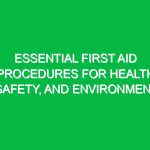Introduction
Fire hazard description is a crucial aspect of health, safety, and Environment (HSE) management. It involves identifying, assessing, and explaining potential fire risks and Hazards within a workplace or community. By effectively describing fire Hazards, organizations can implement preventive measures to mitigate risks, protect lives, and preserve property. In this article, we will explore the essential components of fire hazard descriptions, their significance in the HSE domain, and practical insights for ensuring Safety.
The Importance of Fire Hazard Descriptions in HSE
Understanding fire hazards is not just about compliance; it is about creating a culture of Safety. Fire hazards can arise from various sources, including flammable materials, faulty electrical systems, and human error. By providing clear descriptions of these hazards, organizations can foster awareness among employees and stakeholders, ensuring everyone understands their roles in Fire Prevention.
Consider a manufacturing facility where combustible dust accumulates. Without a detailed fire hazard description that highlights this risk, employees may not recognize the importance of regular cleaning and Maintenance. When hazards are clearly identified and communicated, the likelihood of incidents decreases significantly.
Key Components of Fire Hazard Description
To effectively communicate fire hazards, a comprehensive description should include the following components:
- Identification of Hazardous Materials: Clearly identify all materials that can contribute to a fire, such as flammable liquids, gases, and solids.
- Sources of Ignition: Recognize potential ignition sources, including electrical equipment, open flames, or hot surfaces.
- Environmental Conditions: Discuss factors like temperature, humidity, and ventilation that can exacerbate fire risks.
- Potential Consequences: Describe the possible outcomes of a fire incident, such as injury, loss of life, property damage, and environmental impact.
- Control Measures: Outline existing Safety Measures, procedures, and equipment in place to prevent Fires.
Best Practices for Creating Fire Hazard Descriptions
Creating effective fire hazard descriptions requires diligence and attention to detail. Here are some Best Practices to consider:
- Conduct Regular Risk Assessments: Regularly evaluate fire hazards to keep descriptions up-to-date. This can include walkthroughs, employee feedback, and reviewing incident reports.
- Engage Employees: Involve employees in identifying hazards. Their firsthand experience can provide valuable insights.
- Use Clear Language: Avoid jargon and technical terms that may confuse readers. Use straightforward language that everyone can understand.
- Visual Aids: Incorporate diagrams or images to illustrate hazards. Visuals can enhance comprehension and retention of information.
- Review and Revise: Fire hazard descriptions should be living documents. Regularly review and update them to reflect changes in operations, materials, or Regulations.
Real-Life Examples of Fire Hazard Descriptions
To illustrate the importance of fire hazard descriptions, consider the following hypothetical scenarios:
Case Study 1: A Warehouse Fire
In a large warehouse, a fire broke out due to the accumulation of cardboard boxes near a heating unit. The fire hazard description failed to identify the presence of flammable materials and the ignition source. As a result, the fire spread rapidly, causing significant damage and endangering lives. If the hazard description had included these details, the warehouse management could have implemented proper storage protocols to prevent such an incident.
Case Study 2: Chemical Processing Facility
At a chemical processing facility, an employee noticed that the Fire Hazard Description was outdated and did not include newly introduced chemicals. This oversight led to an explosion that resulted in injuries and environmental contamination. By updating the fire hazard description to encompass all hazardous materials and their associated risks, the facility could have prevented this tragedy.
Regulations and Standards Governing Fire Hazard Descriptions
Several regulations and standards govern fire hazard descriptions within the HSE context. Compliance with these requirements is essential for organizations to ensure safety and legal adherence:
- Occupational Safety and Health Administration (OSHA): osha outlines standards for fire safety in the workplace, requiring organizations to identify fire hazards and implement Safety Measures.
- National Fire Protection Association (NFPA): NFPA provides guidelines for fire safety practices, including the proper description and management of fire hazards.
- International Fire Code (IFC): The IFC establishes regulations for fire Prevention and safety, emphasizing the need for detailed fire hazard descriptions.
Adhering to these regulations not only promotes safety but also fosters a culture of accountability within organizations. Regular Training and audits can ensure that employees are familiar with current regulations and understand their importance.
Potential Hazards and Safety Considerations
While fire hazard descriptions aim to mitigate risks, it is essential to recognize that hazards can evolve. Here are some potential hazards to consider:
- Human Error: Miscommunication or negligence can lead to unsafe practices, such as improper storage of flammable materials.
- Equipment Failure: Malfunctioning equipment can create ignition sources. Regular maintenance and inspections are crucial.
- Environmental Changes: Changes in weather or facility operations can introduce new fire risks. Stay vigilant and adapt hazard descriptions accordingly.
By identifying these potential hazards, organizations can take proactive measures to enhance safety and prevent incidents.
Actionable Advice for Fire Hazard Management
To further enhance fire hazard management, consider the following actionable steps:
- Regular Training: Conduct training sessions for employees on fire safety practices and the importance of fire hazard descriptions.
- Emergency Preparedness: Develop and communicate emergency response plans in case of a fire incident, ensuring everyone knows their roles.
- Invest in Technology: Utilize fire detection and suppression systems to minimize risks. Modern technology can significantly enhance safety.
- Promote a Culture of Safety: Encourage employees to report potential hazards and participate in safety initiatives.
Conclusion
In conclusion, fire hazard descriptions are a critical component of health, safety, and environmental management. By effectively identifying and communicating fire risks, organizations can protect lives, prevent property damage, and ensure compliance with regulations. It is essential for organizations to recognize the dynamic nature of fire hazards and continuously update their descriptions to reflect current conditions and practices.
As we have explored, the significance of fire hazard descriptions extends beyond compliance; it fosters a culture of safety and responsibility. By integrating Best Practices, engaging employees, and adhering to regulations, organizations can create a safer environment for all. The next time you encounter a fire hazard description, remember its importance in promoting health, safety, and environmental Sustainability.


